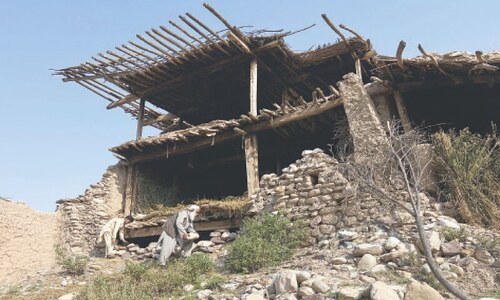PESHAWAR: A British scholar on Wednesday said any attempt to redraw the Durand Line would have catastrophic consequences for the entire region and therefore, Pakistan and Afghanistan should work for a soft border in cultural and social terms.
“It is a paradox that softer borders also allow militants, smugglers and other elements to move across, but stronger states can regulate borders,” Anatol Lieven, researcher and author of the book, Pakistan: A Hard Country, told an international seminar on ‘The Question of Pakhtun Identity in the Pak-Afghan region: Challenges and Prospects.’
The three-day seminar was jointly organised by the Shaheed Benazir Bhutto Women University, Peshawar, and Abdul Wali Khan University, Mardan. Speaker of the KP Assembly Asad Qaiser was the chief guest at the inaugural ceremony, which was attended by academicians, researchers, scholars and students.
British scholar urges Islamabad, Kabul to work for ‘soft border’
Vice-chancellors Professor Razia Sultana of the SBBWU and Professor Ihsan Ali of the AWKU, who were present on the occasion, signed a memorandum of understanding between the two academic institutions.
Mr. Lieven said the presence of millions of Afghan refugees, two-thirds of Pakhtun population, currently lived in Pakistan.
“The weight of the Pakhtun cultural and economic identity is now centered here and not in Afghanistan. This is very important for the Pakhtun collective identity in future,” he said.
He said the division of Pakhtuns proved catastrophic for their identity, exploited by outside powers for their geo-political goals and agendas ‘with disastrous consequences.’
The scholar however warned that any tampering with the borders would have ‘horrendous consequences’ that would result in ‘anarchical space’ for range of extremists.
He said historically, the people with the same ethnicity had been living in different states and cited the example of German, Spanish, Arabic and African-speaking citizens in different states.
There was a growing feeling, he maintained, not to abolish those borders and move the borders but to retain them only to make them irrelevant and soft in cultural and social terms.
The division between the Pakhtuns of the settled areas and tribal areas, he said, was the second biggest issue in the question of their identity.
The problem, he pointed out, arose largely from the resistance of the tribal people to extension of modern state to the tribal areas.
The failure of the state extension to the tribal areas, the British author said, proved disastrous for the Pakhtuns, for the region and the entire world which allowed extremist elements to find sanctuary there. The military campaign, he argued, provided an opportunity to extend the state writ to the tribal areas.
Mr. Lieven said one of the biggest aspects of Pakhtun identity was their mobility and commercial success and thus, making Karachi the biggest Pakhtun city in the world in terms of the number of the population in Pakistan’s largest city.
The Pakhtun transport companies, he said, in a way re-created the empire of Ahmad Shah Abdali that extended to the eastern shore.
He said the western route of the Pakistan-China Economic Corridor would prove beneficial for the Pakhtuns and extend their identity far beyond Pakistan into Afghanistan, China, Iran and Eurasia.
Archaeologist and AWKU Vice Chancellor Professor Ihsan Ali in his presentation traced the archeological history of the region by going back to 40,000 years of the caveman, to Neolithic to the first human settlements in Gomal Valley, Dera Ismail Khan.
“It was never in our culture to kill people. We were a peace-loving people,” he said.
He also referred to the invasion of the Aryan, the advent of Gandhara civilisation and the support the people lent to the Iranian Achaemenid against the Greeks that led Alexander the Great to invade this part of the region.
Dr. Ishan said Pakhtuns were a mixture of all races, debunking arguments by some historians that Pakhtuns were of German race, a lost tribe of the Jews or the Aryans.
Dr. Razia Sultana, a historian by qualification, in her welcome speech said there were approximately 50 million Pakhtuns in Afghanistan and Pakistan but there was no clue as where they came from.
She said the most embarrassing thing was the description of Pakhtuns as terrorists.
“The people abroad look at us as gun-toting, trigger-happy people. We are not terrorists,” she added.
The Pakhtuns’ image and reputation as a warrior and martial race, she continued, was taken advantage of and used as part of the Great Game and later during the Cold War between the Soviet Union and the US.
“We need to find answers to who we are and how we reach this stage and find indigenous solutions to our problems,” she said.
Published in Dawn, April 21st, 2016


































